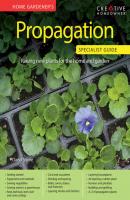Home Gardener's Propagation (UK Only). David Squire
Чтение книги онлайн.

Читать онлайн книгу Home Gardener's Propagation (UK Only) - David Squire страница 5
Название: Home Gardener's Propagation (UK Only)
Автор: David Squire
Издательство: Ingram
Жанр: Сад и Огород
isbn: 9781607652427
isbn:
Propagators
Propagators enable seeds to germinate and cuttings to develop roots without heating the entire greenhouse.
Electric propagator: Clean and efficient, but ensure that it has been safely installed for use in a damp environment.
Unheated propagator with air vents at top
Garden frame
Cold frames are ideal for acclimatizing (‘hardening off’) young plants before you plant them in a garden in late spring or early summer. They are unheated and need to be ventilated during warm weather.
Glass jars
Bell jars are traditionally made of glass and put over newly sown seeds and young seedlings to encourage germination and early growth. You can also use glass jam-jars or plastic bottles with their tops cut off.
Bell jar
Plastic bags
When taking softwood cuttings (see pages 20–21), insert short pieces of split canes into the compost and draw a plastic bag over them; secure the bag around the pot with an elastic band.
Border soil
A sheltered corner with friable, well-drained soil creates an ideal nursery bed for plants. It can also be used for hardwood cuttings (see page 22).
Mist propagation units
Professional gardeners have used mist propagation units for many generations to encourage softwood cuttings to develop roots quickly. Small, amateur units are now available. You insert the cuttings in well-drained compost (slightly heated) and the unit regularly covers the leaves with a thin film of water. This keeps the leaves cool and full of moisture until roots develop. The cuttings should then be transferred to small pots.
Always have electrical equipment installed by an experienced and competent electrician.
TIMING
Choosing the right time to increase plants is vital for subsequent success. Seeds are mainly sown in greenhouses in late winter and spring, and outdoors in spring and early summer. Herbaceous perennials are best divided in spring. Softwood cuttings are usually taken in late spring and early summer (when soft shoots are available); half-ripe cuttings (also known as semi-hardwood cuttings) mainly in mid-summer; and hardwood cuttings from mature wood usually in late summer and early autumn, but they can be taken until late winter.
AFTERCARE
After sowing seeds, dividing plants and taking cuttings, care and attention is needed until the new plant is established and growing strongly. Advice on aftercare is given for each method of increasing plants.
SEEDS
Increasing plants from seeds
Are there many types?
There is a wide range of seeds, from dust-like to winged and plumed, and some are fleshy or hard (see below for details and their special needs when sowing). Sowing seeds is the main method of increasing plants, and usually the least expensive. It is often the key to capturing the attention of young children and turning them into gardeners. They are likely then to grow up into people who appreciate plants and respect the environment.
HARVESTING SEEDS
Although most gardeners buy fresh seeds of vegetables, hardy annuals, half-hardy annuals and greenhouse plants each year, some people like to harvest and save seeds from plants that have flowered. However, the plants that result from such seeds can sometimes be variable (gathering seeds is described below). In addition, where a plant is a hybrid – this is indicated by an x between the first (generic) and second (specific) names – its seeds will not breed true to the type; neither will those of varieties that are F1 hybrids (see box on opposite page for the meaning of this term).
TYPES OF SEED
Seeds can be grouped into six main types, and this has an influence on the way they should be sown.
• Dust-like: These very fine seeds soon lose their ability to germinate, and therefore are best sown while fresh. They include seeds of Begonia and Meconopsis. You need only press them into the surface of the compost.
• Hard-coated: Lathyrus odoratus (Sweet Pea) is an example; crimson and purple-coloured varieties have especially hard-coated seeds. To encourage rapid germination, chip the hard coat with a sharp knife on the side of the seed opposite the ‘eye’ (a process called ‘scarification’).
• Fleshy seeds: Seeds of some vegetables, such as beans and garden peas, have fleshy seeds; encourage germination by soaking them in water for a day or two before sowing. Aesculus hippocastanum (Horse Chestnut), Castanea sativa (Sweet Chestnut) and Quercus (Oaks) have fleshy seeds.
• Oily seeds: These include Magnolia seeds, and they soon lose their ability to germinate; you should sow them immediately after gathering.
• Winged seeds: Trees such as Acer pseudoplatanus (Sycamore), Fraxinus (Ash) and Tilia (Lime) have winged seeds; you can remove the ‘wings’ when you are cleaning them, and sow the seeds in the normal way.
• Plumed seeds: These include Erigeron and Scabiosa (Scabious); sometimes, if the plume is still present, they can be difficult to sow at the desired depth.
GATHERING SEEDS
When harvesting seeds, it is essential to choose a dry, sunny day and to keep the seeds of different species separate. The ‘parent’ plants should be healthy, free from pests and diseases and representative of their kind. Always gather the seedheads or pods before they begin to open. It is better for seedheads and pods to dry out slowly in gentle warmth, rather than quickly in a high temperature.
1 If the whole plant is nearing maturity, you can pull it up, invert it, place it in a thin paper bag and hang it in a dry, airy shed (see left). Alternatively, spread individual seed-heads and pods on sheets of paper and place them СКАЧАТЬ